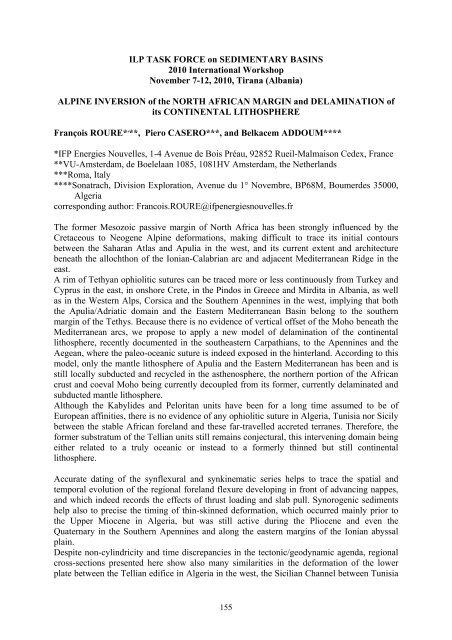DYNAMICS and ACTIVE PROCESSES - International Lithosphere ...
DYNAMICS and ACTIVE PROCESSES - International Lithosphere ...
DYNAMICS and ACTIVE PROCESSES - International Lithosphere ...
Create successful ePaper yourself
Turn your PDF publications into a flip-book with our unique Google optimized e-Paper software.
ILP TASK FORCE on SEDIMENTARY BASINS<br />
2010 <strong>International</strong> Workshop<br />
November 7-12, 2010, Tirana (Albania)<br />
ALPINE INVERSION of the NORTH AFRICAN MARGIN <strong>and</strong> DELAMINATION of<br />
its CONTINENTAL LITHOSPHERE<br />
François ROURE* , **, Piero CASERO***, <strong>and</strong> Belkacem ADDOUM****<br />
*IFP Energies Nouvelles, 1-4 Avenue de Bois Préau, 92852 Rueil-Malmaison Cedex, France<br />
**VU-Amsterdam, de Boelelaan 1085, 1081HV Amsterdam, the Netherl<strong>and</strong>s<br />
***Roma, Italy<br />
****Sonatrach, Division Exploration, Avenue du 1° Novembre, BP68M, Boumerdes 35000,<br />
Algeria<br />
corresponding author: Francois.ROURE@ifpenergiesnouvelles.fr<br />
The former Mesozoic passive margin of North Africa has been strongly influenced by the<br />
Cretaceous to Neogene Alpine deformations, making difficult to trace its initial contours<br />
between the Saharan Atlas <strong>and</strong> Apulia in the west, <strong>and</strong> its current extent <strong>and</strong> architecture<br />
beneath the allochthon of the Ionian-Calabrian arc <strong>and</strong> adjacent Mediterranean Ridge in the<br />
east.<br />
A rim of Tethyan ophiolitic sutures can be traced more or less continuously from Turkey <strong>and</strong><br />
Cyprus in the east, in onshore Crete, in the Pindos in Greece <strong>and</strong> Mirdita in Albania, as well<br />
as in the Western Alps, Corsica <strong>and</strong> the Southern Apennines in the west, implying that both<br />
the Apulia/Adriatic domain <strong>and</strong> the Eastern Mediterranean Basin belong to the southern<br />
margin of the Tethys. Because there is no evidence of vertical offset of the Moho beneath the<br />
Mediterranean arcs, we propose to apply a new model of delamination of the continental<br />
lithosphere, recently documented in the southeastern Carpathians, to the Apennines <strong>and</strong> the<br />
Aegean, where the paleo-oceanic suture is indeed exposed in the hinterl<strong>and</strong>. According to this<br />
model, only the mantle lithosphere of Apulia <strong>and</strong> the Eastern Mediterranean has been <strong>and</strong> is<br />
still locally subducted <strong>and</strong> recycled in the asthenosphere, the northern portion of the African<br />
crust <strong>and</strong> coeval Moho being currently decoupled from its former, currently delaminated <strong>and</strong><br />
subducted mantle lithosphere.<br />
Although the Kabylides <strong>and</strong> Peloritan units have been for a long time assumed to be of<br />
European affinities, there is no evidence of any ophiolitic suture in Algeria, Tunisia nor Sicily<br />
between the stable African forel<strong>and</strong> <strong>and</strong> these far-travelled accreted terranes. Therefore, the<br />
former substratum of the Tellian units still remains conjectural, this intervening domain being<br />
either related to a truly oceanic or instead to a formerly thinned but still continental<br />
lithosphere.<br />
Accurate dating of the synflexural <strong>and</strong> synkinematic series helps to trace the spatial <strong>and</strong><br />
temporal evolution of the regional forel<strong>and</strong> flexure developing in front of advancing nappes,<br />
<strong>and</strong> which indeed records the effects of thrust loading <strong>and</strong> slab pull. Synorogenic sediments<br />
help also to precise the timing of thin-skinned deformation, which occurred mainly prior to<br />
the Upper Miocene in Algeria, but was still active during the Pliocene <strong>and</strong> even the<br />
Quaternary in the Southern Apennines <strong>and</strong> along the eastern margins of the Ionian abyssal<br />
plain.<br />
Despite non-cylindricity <strong>and</strong> time discrepancies in the tectonic/geodynamic agenda, regional<br />
cross-sections presented here show also many similarities in the deformation of the lower<br />
plate between the Tellian edifice in Algeria in the west, the Sicilian Channel between Tunisia<br />
155




